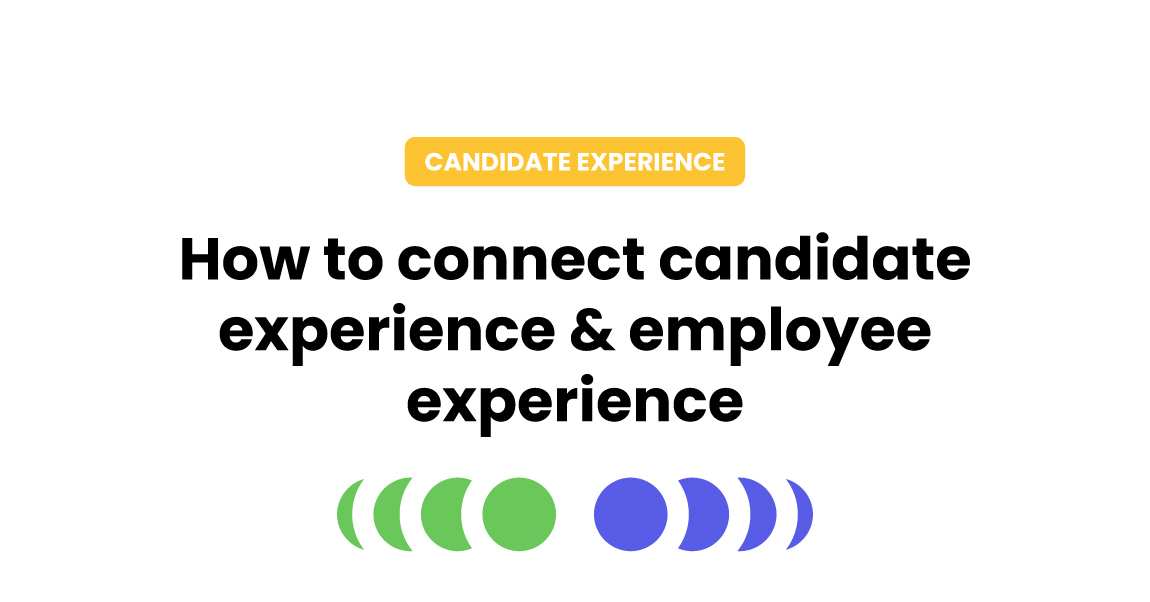What is the ultimate hiring-related phrase you’ve heard tons of times? Maybe you thought it was some mumbo-jumbo but eventually found out that it’s actually kind of crucial. I’ll go first. My favorite recruitment & retention terms are candidate experience and employee experience. Yes, we all bumped into these terms on countless occasions. But what do they really mean? How important are they? And why is the bond between them so strong?
Let’s start by covering the basic definition of these experiences and move toward the best tips and practices.
How do you define candidate experience?
How your candidates perceive and interact with each stage of the hiring process and each participant is a pretty big deal. Also, it’s precisely what candidate experience stands for. It covers multiple aspects and key factors like attracting, sourcing, interviewing, hiring, and onboarding new teammates. So, it’s a sum of the candidates’ thoughts, notions, and opinions about your firm, its procedures, and the people they’ve talked to.
Even though this aspect is quite vital, studies show that only 32% of candidates label most of their experiences with recruitment processes as positive. In fact, most job seekers are very annoyed by the whole drill and the steps they’re obligated to take. So be careful. And take a closer look at the perks you’ll get if you offer smooth and pleasant experiences to those who consider joining your squad.
Why is the candidate experience important?
Turning candidates into brand ambassadors sounds just awesome, right? It sure does. But that’s not all. There are some actual reasons that make dedicating extra attention to this segment inevitable. So, why does candidate experience matter in recruitment? Here are three key points & perks you must know of:
- It saves time and money. By decreasing time to hire and related costs and having basically all recruitment metrics improved, it has a tremendous impact on your company’s overall success.
- It enhances the quality of hires and influences retention rates. In other words, it helps you avoid mistakes and mishires and prevents your crew from being allured toward other job ads.
- It can boost your brand and reputation. And you know what that entails? More qualified applicants, more smooth processes, and no burned bridges between you and top talents.
Simply put, positive experiences turn active and passive job seekers, as well as employees, into the company’s advocates. And so, by spreading the good word through credible professionals, your firm can be recognized and distinguished from the rest.
What is meant by employee experience?
So, we’ve seen a few crucial advantages of candidate-focused recruitment. But here’s what you must know – the battle for talents doesn’t end once you grab their attention. Hiring a dedicated expert is just the beginning of the journey. Once you welcome them to the team, it’s time to direct your focus toward building a superb employee experience.
Now, what does this term stand for? It’s mainly about each employee’s opinions, comments, and feelings they’ve got from the initial step they took within an organization all the way to their exit interview. Or – throughout their full lifecycle. So, employee experience (or just – EX) covers every single touchpoint an employer has with a staff member. It also encompasses the cultural environment and the processes and projects each individual will participate in.
What is the role of employee experience?
Both candidate experience and employee experience have a strong impact on the company’s future and whether it will succeed in attracting and keeping new hires. And they both affect the three key elements: recruitment, retention, and employee engagement.
So let’s begin with the first one – how does EX influence your recruiting tactics and outcomes? Well, studies show that most job seekers pay close attention to the reviews left by previous candidates and former employees. Websites like Glassdoor can have a massive impact on whether a potential hire will embrace the chance to join your team or bail out before you reach the final stage of the process. So here’s a basic tip – make sure no former teammate is bad-mouthing you.
As for improved employee retention, it’s inseparable from EX, engagement, and overall satisfaction of every individual in the firm. The formula is more than simple – motivated and dedicated people will stick around. Also, they’ll perform way better. So, be sure to offer smooth experiences from the pre-boarding and onboarding processes, and keep up the good work throughout their entire journey.
Candidate experience and employee experience: The unbreakable bond
Here’s the fact we all need to grasp – while they are related, candidate experience and employee experience can be very different. The first one’s all about anticipation. Applicants and sourced candidates wait for feedback and more info. It starts with processing their resumes, then scheduling the initial screening, and moves through those next steps that should grant a good interview experience. Finally, the job offer is the most anticipated stage all aspiring job seekers strive for. Now, how about new hires? They usually keep the salary and benefits that attracted them in the first place in mind. But also, they seek learning opportunities. Adopting new skills and amplifying certain knowledge is one of their prime aims. So, it all has to start with a proper onboarding process. In fact, according to research, 1 in 4 new hires choose to quit within the first three months. So, to connect the dots and make things work out just fine, make sure to understand the candidates and their preferences, stick with what you’ve promised, and avoid those ridiculous mistakes many employers make at the very beginning.
# 1 Mistake: Onboarding program gone wrong
Is it possible to start the onboarding process before a new hire’s official first day at the office? Heck yes! And not only that it is possible, but it’s one of the absolute best practices. Not having a structured onboarding program, however, is one of the most common mistakes companies make. So start by setting clear expectations and aligning them properly. Then, ensure to make the right mixture of learning and doing. And while at it, focus on belonging. The lack of support and understanding will push your new employees in another direction and have them seeking a fresh start elsewhere. Finally, bear in mind that interviews and actual workdays have some major differences. In fact, candidates who seem more relaxed and friendly while being interviewed can still need a little nudge when meeting new colleagues. Spot their needs and struggles, and be there for them.
Reality bites: Mismatched expectations
Some candidates say that their day-to-day experience is very dissimilar to what they anticipated. Of course, this sort of gap can occur for a whole range of reasons. For once, the job description and its key requirements can be off. Or, the recruiter can offer the candidate information that’s quite different from what the company can actually offer. Lastly, the hiring needs of the company could change right in the middle of the process. So, how to avoid a massive waste of time and a potential disaster? Thinking ahead and focusing on the results can help the hiring managers dodge this pitfall. Peer interviews can also help companies show what the EX genuinely looks like – from an insider’s point of view.
💡 How to make the perfect blend & avoid these struggles?
So, what’s the basic takeaway here? There’s no effortless way to fill an open position, and the same rule applies to welcoming a new hire. A structured or extended onboarding program can help a lot and make all the difference. And setting it up requires time and some extra effort. Truth be told, that’s the only true way for a new employee to start off on the right foot and learn more about their duties, crew, and company. Recruiters and other HR personnel must be aware of the importance of making the transition from candidate to an employee neat & sweet. Also, mentors, leaders, and work buddies must embrace their roles and offer as much support as needed.
Still, if the whole recruitment and interview process was laced with snooty, snotty, and other sorts of pompous talk (that’s kind of resembling the reality, but no one’s ever gotten quite there yet) – change that ASAP. All the smooth talk and sweet nothings will be discovered and turned into negative reviews eventually. Reconsider your strategies & regroup.
Employee and candidate experience best practices & tested tips
So, by now, you’re absolutely positive about the significance of the proper onboarding process. Also, you’re no stranger to transparency either, and your brand-new aim is to live & recruit by its rules. Now, here are a few more factors you must count on (and make sure to review and refine them):
- Build a simplified and effective recruitment process,
- Write a clear job description and make the application process simple and effortless,
- Be open about your company, including its mission, culture, and everything you’re willing to offer,
- Guide the candidates through the whole hiring process and keep them posted – not ghosted!
- Structure the interviews and reach the ultimate aim here – a good interview experience.
Building up and linking candidate experience and employee experience can’t be done if you skip any of these steps. So start with the tactics your recruiters (or a recruitment agency you work with) use. Do they use any tools? Are they capable of engaging passive talents? Do they understand the bond between recruitment and employer branding? Assess the skills at your disposal and boost your approach. Then, perfect one point at a time.
Candidate experience and employee experience are integral parts of your success
Linking CX & EX isn’t that difficult. Sure, it does take some time to build them up and create a solid bond between the two. But the fact is – one can never thrive without the other. So start canvassing your processes thoroughly. And be sure to begin collecting feedback from job applicants and employees. Don’t fail to hear them out and put their tips into practice. And if you want to refresh your strategies and get the best possible results, talk to us.




